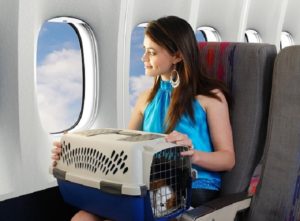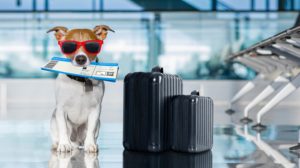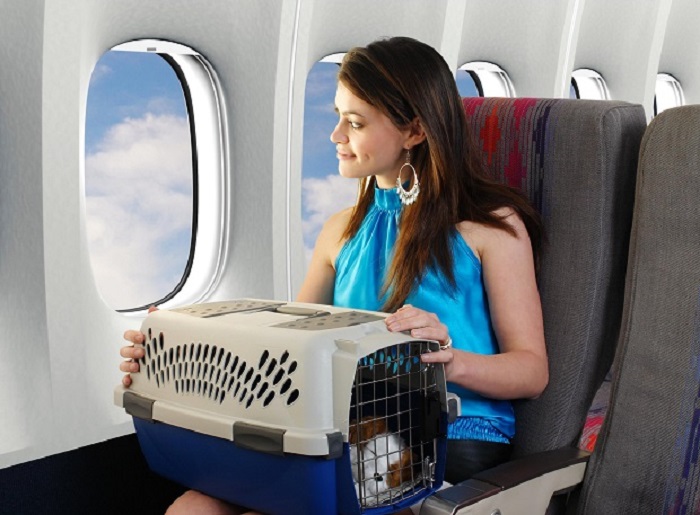
Photo by Counselling on Pixabay
As travel restrictions start to ease, many pet owners are eager to take their furry friends along on their adventures. However, it’s important to be aware that airlines have implemented new rules and regulations regarding pet travel in the past year. Whether you’re a seasoned traveler or a first-time flyer with your dog, it’s crucial to understand the requirements and guidelines set by different airlines. In this comprehensive guide, we’ll cover everything you need to know before flying with your dog, including health considerations, paperwork, carrier requirements, and airline-specific guidelines.
Should You Fly with Your Dog?
Before making any travel arrangements, it’s essential to consider whether flying with your dog is the best option for their health and well-being. Air travel can be stressful for both humans and dogs alike. The unfamiliar sounds, sights, and smells of airports, as well as the change in diet and water, can potentially affect your dog’s gastrointestinal health and overall comfort. Moreover, the upheaval of traveling and changes in time zones can lead to dehydration or disruptions in medication schedules, which can have serious consequences, especially for older dogs or those with underlying medical conditions.
If your dog falls into one of these categories, it’s advisable to fly with them only when absolutely necessary and to ensure you prepare thoroughly to meet their specific needs. It’s always a good idea to consult with your veterinarian before planning any air travel with your dog.
Preparing to Fly with Your Dog: Health Checklist
Once you’ve determined that flying with your dog is the best option, it’s time to start preparing for the journey. Here’s a health checklist to ensure your dog is fit to fly:
-
Schedule a veterinarian appointment 7-10 days before your departure to have your dog examined and ensure they are healthy enough to travel. Take this opportunity to update any necessary vaccinations and obtain a rabies certificate. Even if a rabies certificate isn’t required at your destination, it’s always wise to have one on hand in case of any unforeseen circumstances.
-
Pack an ample supply of any necessary medications your dog will need during the trip, including heartworm and flea/tick preventatives. If your dog is on prescription medication, bring a copy of the prescription and keep a photo of it on your phone in case of emergencies or misplaced medication.
-
If your dog follows a prescription diet or has food sensitivities, make arrangements to ensure they will have suitable food at your destination. This might involve packing enough food for the duration of the trip, obtaining a signed copy of the prescription for their food, or researching local options for purchasing their specific diet.
-
If your dog experiences anxiety during travel, consult with your veterinarian to find suitable ways to manage their nerves. Sedatives are generally not recommended for most dogs, and alternative calming methods such as calming collars or anti-anxiety T-shirts may be more appropriate. If medication is deemed necessary, test it a few days before travel to ensure there are no adverse effects or unusual reactions.
-
If you own a brachycephalic (short-muzzled) breed, such as a Bulldog or Pug, take extra precautions. These breeds are more susceptible to respiratory challenges in high temperatures or humidity. Confinement in a carrier can also cause anxiety, which can exacerbate these conditions. It’s advisable to discuss your travel plans with your veterinarian, as flying may not be the safest option for these breeds. Additionally, most airlines do not permit brachycephalic dogs to travel in cargo.
-
Prior to travel, refrain from feeding your dog for approximately six hours. However, it’s essential to provide them with bottled water to prevent dehydration during the journey.

Preparing to Fly With Your Dog: Airline and Travel Requirement Checklist
In addition to the health considerations, there are several airline-specific requirements and general travel guidelines to keep in mind when flying with your dog. Follow this checklist to ensure you meet all the necessary requirements:
-
Research the quarantine, vaccination, and health certificate requirements at your destination, as well as any regulations for your departure airport. It’s crucial to check these well in advance, gather the relevant records, and make appropriate arrangements. Don’t forget to also consider the regulations for your return trip.
-
Choose a well-ventilated and size-appropriate carrier that meets your airline’s requirements. Your dog will need to remain in the carrier for the duration of the flight, so it’s important that they can stand, sit, and turn around comfortably. For dogs traveling in the cabin, the carrier must fit beneath the seat in front of you. Check your airline’s specifications for the correct dimensions.
-
Keep in mind that if you bring your dog into the cabin, the carrier will count toward your carry-on baggage allowance on most airlines.
-
Ensure your dog is well-behaved and not disruptive. Most airlines require that pets in the cabin exhibit good behavior, which includes not growling, barking excessively, or causing disturbances. Airlines reserve the right to refuse travel to disruptive pets. Consider training your dog and earning their Canine Good Citizen (CGC) title before traveling.
-
Inform your airline in advance that you’ll be traveling with a dog. It’s advisable to be in direct contact with the airline regarding your pet, as some airlines have limitations on the number of animals allowed per flight. This is also an opportunity to double-check if you’ve missed any regulations or requirements.
-
Whenever possible, opt for direct flights to minimize travel time and potential stress for your dog.
-
Consider the time of day when booking your flight. In summer, aim to fly early in the morning or later in the evening to avoid extreme temperatures, especially if you’re traveling to or from a hot destination. In winter, choose midday flights to avoid the coldest parts of the day. Some airlines may have restrictions on flying dogs in cargo or checked baggage during certain temperature ranges.
Choosing the Right Pet Carrier Allowed in Cabin
Selecting the appropriate pet carrier is crucial to ensure your dog’s comfort and safety during the flight. Follow these guidelines when choosing a pet carrier for in-cabin travel:
-
Pets should be able to stand, sit, turn around, and lie down in a natural position inside the carrier without touching the sides or top.
-
Hard-sided, non-collapsible kennels must fit within the under-seat dimensions specified by the airline. Check with the reservations desk to determine the maximum dimensions based on your specific aircraft.
-
Soft-sided, collapsible kennels can be slightly larger but still need to fit under the seat without excessive collapsing. These carriers should be secure, padded, water-resistant, and have ventilation on at least two sides.
One recommended option is the Sherpa Original Deluxe Airline-Approved Dog & Cat Carrier Bag. However, there are other carriers available on the market that meet airline requirements and provide comfort for your dog.
Flying With Your Dog: An Airline-by-Airline Guide

Each airline has its own specific guidelines and policies when it comes to traveling with dogs. It’s crucial to familiarize yourself with the requirements of your chosen airline before booking your flight. Here’s a summary of the guidelines for several major airlines:
Alaska Airlines Pet Travel Guidelines
-
Health and vaccine requirements: Dogs traveling in cargo require a health certificate dated within 10 days of the outward journey and 30 days of the return journey. No health certificate is needed for pets traveling in the cabin, but they must be in good health.
-
Dogs allowed in the cabin? Yes, as long as they’re at least eight weeks old and weaned.
-
Restrictions on dogs in the cabin? Yes, there are limits on the number of pet carriers allowed per flight. First-class can accommodate one carrier, while the main cabin can accommodate up to five carriers. Passengers can have a maximum of two pet carriers in the main cabin, provided the adjacent seat is part of their booking. Up to two dogs can travel in the same carrier if they fit properly and are not in distress.
-
Dogs allowed in cargo/the baggage compartment? Yes, as long as they’re at least eight weeks old and weaned.
-
Fee to travel with your pet? Yes, $100 each way for both cargo and cabin travel.
For more detailed information, refer to Alaska Airlines’ full pet policy.
American Airlines Pet Travel Guidelines
-
Health and vaccine requirements: No specific certificate requirements listed for dogs traveling in the cabin, but it’s advisable to check with the airline.
-
Dogs allowed in the cabin? Yes, on most flights within the US, Canada, Mexico, Central America, and some other destinations. Dogs must be at least eight weeks old.
-
Restrictions on dogs in the cabin? There is a maximum number of kennels allowed on each flight, excluding service animals. The number varies depending on the flight.
-
Dogs allowed in cargo/the baggage compartment? Yes, but due to pandemic-related changes, checked pet service is currently unavailable, except for active-duty US military traveling on assignments.
-
Fee to travel with your pet? Yes, fees vary based on size, destination, and type of travel. Carry-on fees start at $125.
Refer to American Airlines’ full pet policy for complete details.
Delta Air Lines Pet Travel Guidelines
-
Health and vaccine requirements: No specific certificate requirements mentioned for dogs traveling in the cabin, but it’s advisable to check with the airline.
-
Dogs allowed in the cabin? Yes, as long as they’re at least 10 weeks old for domestic travel, 15 weeks old for travel to or from the European Union, and 16 weeks old for travel to the US from other countries.
-
Restrictions on dogs in the cabin? The number of pets permitted per flight varies depending on the aircraft, with a maximum of four allowed. Pets are admitted on a first-come, first-served basis. There are exceptions for puppies traveling together.
-
Dogs allowed in cargo/the baggage compartment? No, at the time of writing, dogs may not be checked in cargo due to pandemic-related changes.
-
Fee to travel with your pet? Yes, fees start at $125 for travel within the US, Canada, and Puerto Rico.
For additional information, refer to Delta’s full pet policy.
Frontier Airlines Pet Travel Guidelines
-
Health and vaccine requirements: Frontier does not require a health certificate for dogs traveling in the cabin on domestic flights, but certain destination states might. Health certificates are required for international flights.
-
Dogs allowed in the cabin? Yes, on all domestic flights and flights to/from the Dominican Republic and Mexico.
-
Restrictions on dogs in the cabin? Passengers are requested not to provide food or water to their dogs during the flight.
-
Dogs allowed in cargo/the baggage compartment? No.
-
Fee to travel with your pet? Yes, $99 each way.
For complete details, consult Frontier’s full pet policy.
Hawaiian Airlines Pet Travel Guidelines
-
Health and vaccine requirements: Health certificates are required for dogs traveling in the cabin and cargo/the baggage compartment. Contact the Hawaii Department of Agriculture before travel for information on quarantine and vaccines.
-
Dogs allowed in the cabin? Yes, on certain flights.
-
Restrictions on dogs in the cabin? The total weight of the pet and carrier must not exceed 25 pounds. Passengers with pets in the cabin are asked to check in one hour before general check-in. Hawaiian Airlines does not count carry-on pets toward the carry-on luggage limit.
-
Dogs allowed in cargo/the baggage compartment? Yes, but the weight of the pet and carrier must not exceed 70 pounds.
-
Fee to travel with your pet? Yes, fees vary based on the destination and type of travel.
For detailed information, refer to Hawaiian Airlines’ full pet policy.
JetBlue Pet Travel Guidelines
-
Health and vaccine requirements: Dogs require ID tags and a pet license. JetBlue does not require any specific health or vaccine certifications, but passengers are responsible for complying with animal import requirements at their destination.
-
Dogs allowed in the cabin? Yes, on all domestic flights and select international flights.
-
Restrictions on dogs in the cabin? There is a limit of four pets per flight, and the combined weight of the dog and carrier must not exceed 20 pounds. Only one pet is allowed per carrier.
-
Dogs allowed in cargo/the baggage compartment? No.
-
Fee to travel with your pet? Yes, $125 each way.
For complete details, refer to JetBlue’s full pet policy.
Southwest Airlines Pet Travel Guidelines
-
Health and vaccination requirements: Southwest does not list specific health certification requirements, but passengers are responsible for complying with any health or quarantine requirements at their destination.
-
Dogs allowed in the cabin? Yes, on domestic flights. However, dogs are not allowed on international flights or itineraries that include international flights. Dogs must be at least eight weeks old.
-
Restrictions on dogs in the cabin? Southwest permits up to six pet carriers per flight, with a maximum of one carrier per customer. Two pets of the same species may travel in a single carrier.
-
Dogs allowed in cargo/the baggage compartment? No.
-
Fee to travel with your pet? Yes, $95 each way per carrier.
For more information, consult Southwest’s full pet policy.
Spirit Airlines Pet Travel Guidelines
-
Health and vaccination requirements: Spirit does not require a health certificate for dogs traveling in the cabin, except for travel to the US Virgin Islands. A rabies certificate is required for pets traveling to Puerto Rico.
-
Dogs allowed in the cabin? Yes, on domestic flights only. Dogs must be at least eight weeks old and weaned.
-
Restrictions on dogs in the cabin? One pet carrier is allowed per guest, with up to two pets permitted in a carrier. The combined weight of the pet and carrier cannot exceed 40 pounds.
-
Dogs allowed in cargo/the baggage compartment? No.
-
Fee to travel with your pet? Yes, $110 per pet container, each way.
For complete details, refer to Spirit’s full pet policy.
United Airlines Pet Travel Guidelines
-
Health and vaccination requirements: All animals entering the US must have a valid certificate of rabies vaccination completed at least 30 days before arrival.
-
Dogs allowed in the cabin? Yes, on domestic flights except to and from Hawaii, and on select international flights. Dogs must be at least 16 weeks old.
-
Restrictions on dogs in the cabin? Economy class allows a maximum of four pet carriers per flight, while premium classes allow two carriers. Pet carriers do not count toward the carry-on baggage limit. Pit bull breeds are not allowed in the cabin.
-
Dogs allowed in cargo/the baggage compartment? No, at the time of writing, United’s PetSafe cargo program has been suspended due to the pandemic.
-
Fee to travel with your pet? Yes, fees start at $125 each way, with an additional service fee for certain stopovers.
For full details, refer to United’s pet policy.
Conclusion
Flying with your dog can be an exciting and rewarding experience, but it requires careful planning and consideration. Before booking your flight, assess whether air travel is the best option for your dog’s health and well-being. If you decide to proceed, consult with your veterinarian, gather the necessary paperwork, and ensure you meet all the requirements of your chosen airline. By taking the necessary precautions and following the guidelines provided, you can make your journey with your furry friend as smooth and comfortable as possible. Have a safe and enjoyable trip!
